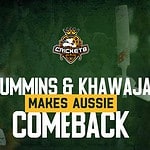Mitchell Starc picked up another 4 wickets on his way to 350 wickets in the first day of second test at the Gabba. The West Indians struggled initially but Josh Da Silva and Kavem Hodge put on a fantastic partnership to keep the West Indies in the game. The Australian bowlers made a late comeback with three quick wickets, but the game was nicely balanced after an action packed in front of a packed crowd in Brisbane.
Team Lineups
The Australian playing XI remained unchanged despite the spread of Covid in their camp. Coach Andrew McDonald and all-rounder Cameron Green tested positive for Covid on Wednesday. Green was on the team sheet however, much to the bewilderment of cricket fans.
The all-rounder from New South Wales stood apart from the rest of the team during the national anthem and fielded on his usual gully position. He even bowled in the second session. Travis Head was also tested positive earlier this week. But the centurion from the first test recovered in time to make the team. Usman Khawaja took a blow to the head which forced him to retire in the first match. Two fantastic catches at the first slip indicated he was fit enough. Steve Smith will open the batting again, that means Cameron Green will be given a slot at no. 4.
West Indies made one change to the team that was comprehensively beaten by the hosts in Adelaide. 24 year old Guyanan off spinner Kevin Sinclair came to the squad in the place of left-arm orthodox bowler Gudakesh Motie. The young sensation Shamar Joseph played his second test after shining in his debut match in Adelaide. Kraigg Brathwaite leads a young side full of wonderful talents.
Australia
1. Usman Khawaja 2. Steve Smith 3. Marnus Labuschagne 4. Cameron Green 5. Travis Head 6. Mitchell Marsh 7. Alex Carey (WK) 8. Mitchell Starc 9. Pat Cummins (Cap.) 10. Nathan Lyon 11. Josh Hazlewood
West Indies
1. Kraigg Brathwaite (Cap.) 2. Tagenarine Chanderpaul 3. Kirk McKenzie 4. Alick Athanaze 5. Kavem Hodge 6. Justin Greaves 7. Joshua Da Silva (WK) 8. Kevin Sinclair 9. Alzarri Joseph 10. Shamar Joseph 11. Kemar Roach
West Indies captain Kraigg Brathwaite won the toss and elected to bat first. The pitch looked green with hints of grass sprinkled all around it. Traditionally the Gabba pitch offers pace and bounce for the quick bowlers. But once the ball gets softer, it comes into the bat nicely. The key to playing on a wicket like this is seeing off the early spell of pace bowling. The pacers may get some purchase off the wicket in the first session.
The batsmen with patience is sure to get rewarded. The average first innings score at this venue is 230 over the last 20 matches. Brathwaite may have taken the decision of batting first given the history of this ground. At the Gabba, only 27% of the matches have been won by the team batting first. But it would surely take something special to beat the World Cup champions in their own backyard.
Fixture
This is the 120th time in Test matches these two teams are facing each other. Australians clearly have the upper hand with 61 wins to West Indies’ 32. 25 of the matches ended in a draw. These two nations were involved in an action packed tie match six decades earlier. That game was also played in Brisbane, in the 1960-61 season.
On Australian soil, the hosts are usually the dominant force with the hosts winning 40 matches to the West Indies’ 18. The West Indies were whitewashed in the last test series involving these two teams, back in the 2022-23 season. The West Indies have failed to manage a single victory in the land down under since the turn of the century. The last time they achieved this feat was back in 1996-97.
| Venue | The second and final Test match between Australia and West Indies was played in the iconic Gabba in Brisbane. |
| Date | The game started on Thursday, 25th January, 2024 at 10:00 a.m. IST. |

Captaincy & Tactics
The Australians maintained a tight line just around the off stump to stifle the West Indian batsmen. Even the fiery Mitchell Starc was reluctant to attack the stump, rather pitching his deliveries around the corridor of uncertainty. Starc picked up two quick wickets early in the innings by generating extra bounce off the surface. The West Indies top order batter could not resist the temptation off playing the ball away from the body.
It was all about sideways movement in Adelaide. In this match, the green pitch enabled the fast bowlers to extract extra bounce off the Gabba wicket. The top six batsmen from the West Indies team was caught behind the stumps. On some other day, the could have left those deliveries. The visitors were reduced to 64 for 5 after a brilliant collective effort by the Australian bowling quartet. Things were eerily falling into a familiar pattern for the West Indians.
Nevertheless, two fearless right handers came to the rescue for the West Indians. They were tried and tested, but stood strong for nearly 52 overs. The pair played some delectable shots on the offside. Unlike their teammates, these two dealt with the outside off deliveries with dexterity. They let the pink ball soften and pitch flatten before launching an assault.
The fuller deliveries were nicely put away through the cover and straight regions. After the new ball was taken, the Australian got back in the game with conviction. Alzarri Joseph then came in with some late fireworks. The Antiguan first bowlers rode his luck through an entertaining innings against the Aussie quicks. The West Indians kept batting till stumps thanks to a resilient innings by Kavin Sinclair. On the second day, Sinclair would be a figure if the West Indies want to put on a good total before the Australians.
Pat Cummins was a frustrated figure through the second session as Australian bowlers were ineffective against the dynamic duo of Josh Da Silva and Kavem Hodge. The Australian skipper went through seven bowlers in the second session to break the partnership. But the Caribbean duo remained unfazed and put together a fantastic partnership of 149 runs in 52 overs.
Batting Analysis
After losing skipper Kraigg Brathwaite early in the innings, the Tagenarine Chanderpaul ans Kirk McKenzie steadied the ship through the early troubles. But both got out in a similar fashion that would surely frustrate their head coach Darren Sammy. Alick Athanaze and Justin Greaves also followed the top order quickly back to the hut, nicking the ball behind the wicket. The West Indians were reeling at 64 for 5 before the dinner break. The pink ball magician Mitchell Starc has unboxed his tricks once again.
From that point on, it was a show by the two right handers. Kavem Hodge was punishing Nathan Lyon for his wayward bowling line. He also hit Mitchell Starc for a six, a sign of defiance from a touring batter. Da Silva was all about touch and grace. The Trinidadian wicketkeeper batsman hit seven boundaries in his innings. There were some flowing cover drives and picturesque straight drives to ease the nerves. The 149 partnership for the sixth wicket is the highest ever against Australia in day-night Test matches.
It was the career best innings from Kavem Hodge. The 30 year old only managed 15 runs altogether in the two innings of the first test match. He was positive, playing the ball on the front foot and putting away the bad deliveries. He played like a seasoned veteran against all odds, hitting the ball in the middle with impeccable craftsmanship.
Alzarri Joseph came to the pitch with all guns blazing. The 27 year old pacer from Antigua was not daunted by the presence of Josh Hazlewood. He hit seven boundaries in his innings of 32 off 22 deliveries. Kevin Sinclair blocked the rest of Mitchell Starc’s over to make sure his side would get the chance to extend their first innings score.
Bowling Analysis
Mitchell Starc became the 27th bowler in Test history to reach the milestone of 350 wickets. He is the third left-arm after Washim Akram and Chaminda Vaas reaching the milestone earlier. Starc is the fifth Australian to reach this milestone, the third pacer after Glenn McGrath and Denis Lillee. It has been a summer of milestones for the Australian bowling quartet. Nathan Lyon picked his 500th wicket in the last series against Pakistan. Pat Cummins and Josh Hazlewood both reached the milestone of 250 Test wickets.
Starc was rewarded for his persistence in maintaining a perfect line outside the off stump. He picked up three wickets before the dinner break. Starc ended the day with four wickets to his name. The tall fast bowler is often unplayable in day-night test matches. In 12 outings, he has picked up 65 wickets at an astounding average of 18.09. After the day’s play Starc stated that the pitch felt too firm for him. The 33 year old would look to achieve the 14th fifer of his test career by picking up another wicket early on.
Josh Hazlewood started the landslide for the West Indians by sending their skipper Kraigg Brathwaite back to the pavilion. He was the chief architect of destruction against Pakistan in the last series. The pacer also grabbed the last wicket of the day’s play, dismissing Alzarri Joseph on the fourth ball of the ninth over. Patrick Cummins was excellent with his line and length but bagged only one wicket. Nathan Lyon struggled throughout the day to put his stamp on the game.
The off spinner remained wicketless in his first twenty overs, costing 58 runs. He grabbed two wickets in the final session however to bring Australia back in the contention strongly. Pat Cummins called in his part-timers including Marnus Labuschagne and Travis Head to break the 6th wicket partnership. Mitchell Marsh and Cameron Green also bowled. None of these bowlers managed to get any wicket.

Fielding Analysis
It was a mixed day for the Australians in the field with some brilliant catches interspersed with some rare aberrations. Cameron Green missed a tough chance to catch Kavem Hodge at the gully. Another edge from the right hander did not carry to Mitch Marsh at second slip. On some occasions, the edge induced flew over the slip cordon towards the boundary.
Steve Smith was displaying his agility though, the recently top order batter turned opener took three catches on the first day at Gabba. Smith (176) is just behind Joe Root (183) in the list of most catches among the active players. Usman Khawaja was also brilliant beside him. The veteran batter took two catches. Wicketkeeper Alex Carey also pouched two chances that came his way.
Marnus Labuschagne was brilliant in the outfield by diving and saving regular runs. The Australian fans might have missed the service of a dedicated fielder like David Warner. The opener played his last test against Pakistan at the SCG earlier this month. However, the Australian management would have to look for young guns in the field as the current crop of players are reaching the last part of their respective careers.
Key Performances
It was a day that was highlighted by two fearless batters from the West Indies. Joshua Da Silva and Kavem Hodge showed the needed resilience and authority to start a counterpunching enterprise. The wicketkeeper batsman Josh Da Silva scored 79 runs before getting trapped in front by Nathan Lyon. Kavem Hodge accumulated 71 runs before becoming the fourth victim on a historic day for the left arm fast bowler.
The pair of Hodge and Da Silva added 149 runs for the 6th wicket partnership, this is the second highest partnership by a touring side in Australia this summer. Both Tagenarine Chanderpaul and Kirk McKenzie got out after getting to 21 at the top of the order. Alzarri Joseph played an enterprising knock of 32 runs from 22 balls. The Antiguan hit 7 boundaries to entertain the packed crowd at the Gabba.
Mitchell Starc became the fifth bowler in Australian Test history to get past the 350th wicket mark. The 33 year old ended the day’s play with four wickets to his name. Josh Hazlewood exuded confidence and control, the towering bowler from Bendemeer claimed two scalps. Nathan Lyon had to toil hard, but the Aussie great finally got his reward on the 21st over. Pat Cummins dismissed Kirk McKenzie to claim his only wicket on the first day.
Turning Point
The Australian bowlers gained control of the first session by picking up five wickets. After that it was a batting shot presented by Joshua Da Silva and Kavem Hodge. This right hand duo put together a partnership of 149 runs to frustrate Pat Cummins. The usually charismatic Nathan Lyon was kept at bay the the batters. Kavem Hodge was using his feet and played some beautiful drives off Lyon. The legendary spinner remained wicketless through his first twenty overs. He delivered at the right moment though, picking up Josh Da Silva three over before the second new ball was due. The score was at 213/5 after 77 overs.
Joshua Da Silva was batting at 79 from 156 deliveries. Nathan Lyon was bowling from around the wicket and pitched the first delivery of his over on the leg stump line. Da Silva tried to block ball on the back foot but it was too late. The ball struck his pad and the Australians appealed vigorously. The umpire had little choice but to raise his finger. The decision was accurate and West Indies could not overturn the decision through DRS. It was the first wicket in 52 overs for the Australians and the Gabba crowd breathed a collective sigh of relief. This wicket enabled the Australians to make inroads and take two more wickets before the end of the day’s play.
Day Result
West Indies were 266 runs ahead after the first day’s play in Gabba. Kraigg Brathwaite won the toss and chose to bat first on a pitch with a green covering.
Brief Scorecard
| West Indies First Innings: 266/8 (89.4 overs) | Australia 1st Innings: Yet to Bat |
| Joshua Da Silva 79 (157) | |
| Kavem Hodge 71 (194) | |
| Mitchell Starc 4/68 (20 overs) | |
| Josh Hazlewood 2/32 (16.4 overs) |

Day Highlights
Day Wrap-Up
The West Indians have had their days of woe in recent tours to Australia. But this bunch of boys from the Caribbean have shown courage and resilience in the face of adversity. After early trouble, the brilliant duo of Josh Da Silva and Kavem Hodge put on a fantastic partnership to keep Australians in the game. Three quick wickets late in the day means Australia might be slightly ahead but the game is nicely poised. It would be interesting to see how long the West Indian tailenders can bat on. If they can set a target of more than 350 runs, it would definitely test the mettle of the Australians on a grassy surface.




